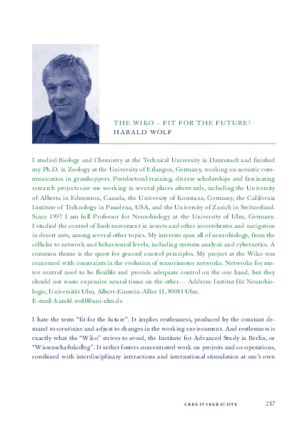
Harald Wolf, Dr. rer. nat.
Professor of Neurobiology
University of Ulm
Born in 1955 in Berlin
Studied Biology and Chemistry at the Technische Hochschule Darmstadt
Focus
Functional and Structural Constraints in the Evolution of Sensorimotor Networks
Project
The Motor Control Network in Locust Flight - Segmental Organisation and Sensorimotor Interactions
Project of the Focus Group: A modelling approach shall address questions of structure-function relationship in neuronal networks, of constraints that limit functional flexibility, and of the evolution of motor control networks. Evolutionary considerations may include energetics and scaling problems.Despite the frequent use of neuronal network modelling in (neuro-)informatics - e. g. as an adaptive tool to solve complex control tasks - and in (neuro-) biology - mostly in pursuit of cellular signalling mechanisms - the present set of questions has received little attention. We shall address the properties of (sensorimotor) networks on the levels of network structure and its general implications for network function, functional flexibility and the association of structural and functional changes during evolution. This may reveal how novel network features are linked to morphological and functional changes of the body they control, and it may yield general insights that bear upon areas ranging from artificial network design for technical control tasks to the understanding of nervous system evolution.
Well-known physiological networks shall be compared on a conceptual level. Candidate networks are those underlying peristaltic vegetative motor patterns (e. g. the crustacean stomatogastric system or vertebrate respiration network), crawling and swimming of legless organisms (e. g. leech or lamprey locomotion), rhythmic action of locomotor appendages (e. g. insect walking or flight), and aimed limb movements.
Individual Project: The control network for locust flight is among the best-studied neuronal networks, particularly with regard to the integration of sensory feedback with central-nervous rhythm generation. Nonetheless, many intriguing features still await scrutiny. In the present context, the distributed and monolithic organisation of the flight control network is of particular interest. Usually, the control circuits of segmental appendages - legs and wings - exhibit a corresponding segmental and bilaterally symmetric organisation. For example, basic motor control of both vertebrate and insect legs is by one dedicated control network per appendage. These (hemi-)segmental networks are connected by a small number of pathways that allow coordinated movements of the appendages. The functional and evolutionary reasons for the exceptional monolithic structure of locust flight control are enigmatic. Modelling of the locust flight oscillator with evolutionary algorithms is expected to shed light not only on the functional reasons for this feature, but also on general principles of network organisation.
Recommended Reading
Wolf, H. 1995. "Plasticity in insect leg motor control: interactions between central program and sensory signal processing." Verh. Dtsch. Zool. Ges. 88.2: 153-164.
Wolf, H. and R. Wehner. 2005. "Desert ants compensate for navigation uncertainty." J. Exp. Biol. 208: 4223(4230.
Ausborn, J., W. Stein, and H. Wolf. 2007. "Frequency control of motor pattern by negative sensory feedback." J. Neurosci. 35: 9319-9328.
Colloquium, 20.10.2009
Insect science, movement control, and navigation
What is the objective of studying insects, considering that most sciences are - justifiably - human-centred, from medicine to philosophy?
When viewing insects from a biological perspective, it is striking that this animal group represents almost 80% of all animal species described to date, or more than 1.5 million species. Insect biomass may amount to almost 10% of living matter on earth. Not surprisingly, then, insects have a strong impact on human life - as pests, parasites, and as suppliers of essential ecological services, from pollination to pest control.
In motor control research, insects provide important model systems. They are not just easy to breed and ethically inoffensive to experiment with. They also possess relatively small numbers of nerve cells - several hundreds to thousands per ganglion - while producing behaviours that equal in complexity those of vertebrates. This makes them attractive and tractable model systems, for instance, when analysing neuronal network function.
A major merit in my personal view is the fact that insects have evolved independently of vertebrates for a long time. For instance, they independently acquired legs and walking. If nonetheless the control principles governing leg movements are similar, this cannot be the result of common evolutionary origin. Rather, it must reflect general requirements of (leg) motor control. And it is such general principles I am interested in.
This shall be detailed for the example of reflex reversal between the control modes of "posture maintenance" and "walking", and particularly for the transition from stance to swing phase in walking. The switch from stance to swing is triggered by the combined parameters "posterior leg position" and "leg unloaded" in all legged animals studied so far. This is a viable control principle functionally, but it also has interesting neuronal implications.
General principles shall further be addressed in insect navigation, in the desert ant Cataglyphis. While these animals are small (<12mg), with appropriately small brains (ca. 1mg and some 100.000 neurons, most of those in the optic lobes), their navigation feats are striking. Ecological situations in the desert biotope require particular orientation strategies, for instance, due to the common absence of landmarks.
Path integration, or dead reckoning, is thus a major navigation strategy employed by desert ants. Path integration requires as basic "instruments" a compass and an odometer (distance gauge), for the (approximate) vector summation of path segments. Ants use sun azimuth and skylight polarisation pattern as a compass, and a stride integrator as odometer. The mechanism of stride integration - colloquially, "step counting" - was proven only recently and shall be presented in some more detail.
Olfactory orientation is another of several orientation strategies desert ants may employ. Olfactory orientation not only allows localisation of small and inconspicuous (though odorous) items. It may also be employed by scientists to study the ants' own assessment of their navigation accuracy - which is surprisingly exact with a maximum error angle of some 8 degrees.
Publications from the Fellow Library
Wolf, Harald (2014)
Inhibitory motoneurons in arthropod motor control : organisation, function, evolution
Wolf, Harald (Cambridge, 2012)
Establishing food site vectors in desert ants
Wolf, Harald (Lausanne, 2012)
Re-visiting of plentiful food sources and food search strategies in desert ants
Wolf, Harald (Amsterdam [u.a.], 2012)
Wolf, Harald (Amsterdam [u.a.], 2011)
Wolf, Harald (Cambridge, 2011)
Activity of the claw retractor muscle in stick insects in wall and ceiling situations
Wolf, Harald (Cambride, 2011)
Odometry and insect navigation
